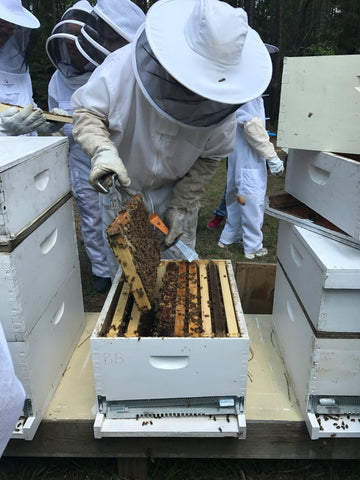Proactively Managing Bee Hive Expansion
By Chari Elam
Warning! Warning! Spring has sprung, whether the temperature and weather conditions seem like it or not! There is not a beekeeper around who hasn’t been nose to the window all winter waiting for the first bud to pop on a maple or elm tree. (I dare you to say I’m wrong.) Now that they have seen that first bud, we have work to do!
Picture the inside of your hive right now. Thousands of worker bees old and new are milling around with one focus in mind—build population for the nectar flow to build a honey crop for next winter. It seems so simplistic that their minds are truly focused on only two seasons: spring and winter. But when you dissect those two seasons, there is so much activity required by both the bee and the beekeeper to pull it off successfully, it justifies stressing the importance!
Staying ahead of growth is a real challenge. Whether you are building bees for honey production or preparing for splits, let’s face it—you’re building bees so that you can split, yet doing so meticulously to avoid swarming. Consider this: A queen bee lays eggs at a rate of 2,000 per day (give or take). There are 3,200 cells per side of a deep frame (6,400 per frame). It takes a queen only three days to fill a frame with developing brood. Within three weeks, you are gaining approximately 6,400 bees per frame of brood per colony. In all reality, most hives will see an increase of 35,000 or more bees over the course of the next month to six weeks! Wow! Can you keep up with that? The answer is yes, in case you didn’t feel the bold confidence needed to express it.

Start now!
For every hive that is more than 80% full of bees, you need to add a box. Here are some recommendations:
- Use drawn foundation in the added brood box
- Pyramid the frames
- Feed
- Equalize your beeyard
1) Drawn comb:
I realize that not everyone has drawn comb stored in abundance. Foundation is fine, but know that you will have to feed. Although I suggest that you feed regardless, the importance of syrup is much greater when comb needs to be drawn. It takes the bees’ consuming “nectar” (thin syrup) nonstop for their wax glands to be stimulated and continue to produce wax. This is so important Quote:
Bees use about 6 lb. of honey to produce 1 lb. of wax. Bees can produce 8 wax flakes in around 12 hours, so that gives you an idea of how patient and arduous they are in building comb for their babies and food.
2) Pyramiding:
Not all beekeepers adopt this mentality. We learned this method when we were researching the topic “maximizing honey production” years ago for an ABF conference. In our research, we found Morris Ostrofsky’s article on basing honey yield on the ability for bees to reach maximum population quickly by pyramiding the second (additional) brood box Quote.
Pyramiding is a technique that can be used to give the queen and workers instant access to two brood boxes thus increasing population while reducing crowding. Pyramiding is done at the time a second brood box is added to a hive that has one brood box. If at all possible, using drawn frames is always preferable to foundation frames.
In Ostrofsky's version of pyramiding, he pulled half of the frames of brood from the bottom box with no mention of the stage of the brood. We have found that pulling a frame of open brood along with resource frames containing brood of all stages works well to draw the queen up to continue laying in the open brood frame.
3) Feed:
The importance of feeding your bees cannot be overstated. As populations grow at an explosive rate, nature is falling short of producing the resources needed to keep up with the demand of food for all of the larval mouths to feed (figuratively speaking). Bees starve in March. That may sound like a harsh statement, but it makes sense when you absorb the explanation of population growth I described previously. Convert to 1:1 sugar syrup now. This emulates the viscosity of nectar and will be readily accepted and used accordingly. Don’t stop feeding until the nectar flow begins in your area. For two-thirds of the nation, that will be around mid-April to the beginning of May. Check out our selection of bee feeders.
4) Equalizing your beeyard:
I’ve written and rewritten articles on this topic several times. Equalizing your bees ranks among the top three beekeeping-management skills needed to be successful. Because one or two of you are wondering, the other two are controlling Varroa mites and providing good nutrition. Read the article “Bee Yard Shuffle,” then do it!
Happy spring, y’all!


